World’s worst-polluting pair of superpowers work on climate
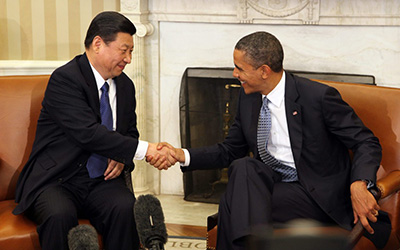
Dedicated to Rita Alice Elizabeth Wright
25 August 1916 – 26 April 2013
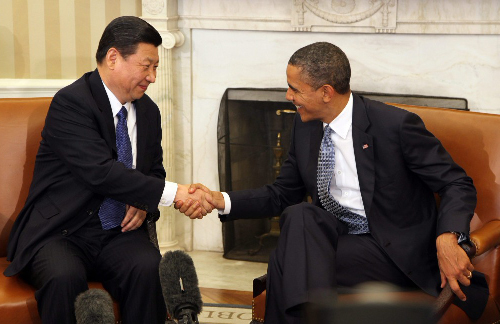
Presidential Action Plan: Presidents Xi Jinping and Barack Obama are behind a high-powered working group that could, finally, see large-scale climate action mobilisation. image EPA/Martin H Simon
Amidst a rash of high-profile setbacks, he’s just played a blinder.
What little remained of President Barack Obama’s gun control legislation has been unceremoniously buried by the gun manufacturers, in cold-blooded disregard for the funerals for 20 children slain at Sandy Hook. This, hard on the heels of a Republican-dictated budget heaping yet more hardship and pain on the poorest Americans.
Attracting miniscule media interest, even before the Boston Marathon bombings, the twin declining and ascending superpowers have established a high-powered working group charged with ‘large-scale cooperative action’ on anthropogenic global warming, potentially marking an historic turning point:
Such action is crucial both to contain climate change and to set the kind of powerful example that can inspire the world.
The Climate Change Working Group will be led by United States special envoy for climate change, Todd Stern, and Xie Zhenhua, vice chairman of China’s National Development and Reform Commission. In July, they will present a report to the United States – China Strategic and Economic Dialogue, established by President Obama and President Xi Jinping’s predecessor in 2009.
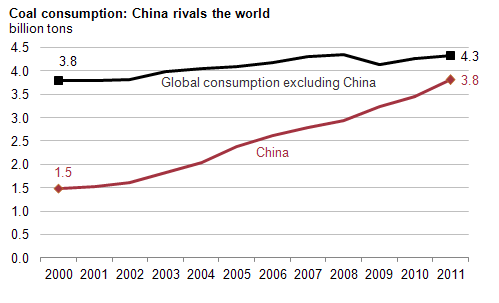
On Way to World Domination: By 2017 China is forecast to consume more coal than the rest of the world combined, which should have the whole world praying that the ‘large-scale cooperative action’ promised by the United States includes helping China further fast-track its nuclear power programme. chart US Energy Information Administration
In 2006, China overtook the United States as the world’s biggest carbon dioxide polluter. No end of ill-conceived Kyoto-style protocols was ever going to make a blind bit of difference without the world’s top twin polluters. Only by redirecting the rampant, aimless consumerism of the United States—fossil-fueled offshore in China—while simultaneously reducing population, can greenhouse gas emissions be rapidly reduced. Fortunately, the Chinese administration is strongly motivated to reduce fossil fuel use on three counts: Firstly, ‘airpocalyptic’ air pollution is killing Chinese citizens in unprecedented numbers—1.2 million in 2010. Despite outward appearances, the People’s Republic is extremely wary of people power—power could swiftly be wrested from the presiding administration, should it be perceived as indifferent to the burgeoning death toll. Secondly, China, unlike the United States, has never demeaned itself with phoney debates about the existence or cause of anthropogenic global warming. China knows full well that climate disruption will savagely impact its people. Finally, China recognises that its vast energy needs can be more economically and cleanly met by rapidly ramping up its nuclear power generating capacity. The escalating coal consumption of its coastal provinces so outstripped the ability of rail networks to supply domestic product from China’s coal-rich northern and western regions that in nine years the country flipped from being the second largest exporter, in 2002, to the largest importer, overtaking Japan. In turn, Japan is being chased by India, but by 2017, China will be burning more coal than the rest of the world put together.
Only with Chinese and the American scientists and engineers working shoulder to shoulder on a Liberty Ship –scale production of small modular and fourth-generation power plants, is there any prospect of sufficient coal being left undisturbed for runaway—or mini-runaway, by one definition—global warming to be averted. While planet-saving use of nuclear is guaranteed deeply offend the sensitivities of many, unlike photovoltaic panel technology, it will make a measurable difference as to how quickly global temperature rises, and to the prospects for survival of billions. Not that photovoltaic is likely to be completely left high and dry—panels are a huge, and heinously polluting, export business for their largely unregulated Chinese manufacturers.

21st Century Liberty Ships: The Obama administration has kick-started the design of factory assembled small modular reactors that could revolutionise the energy industry. The manufacture of these versatile power plants will need to be on a Liberty ship –scale, if China’s coal use is to be drastically curtailed. rendering NuScale
The world’s biggest consumer and biggest producer of consumables are economically joined at the hip. As of January, the United States owed China $1.26 trillion. The United States would dearly love China to allow its currency to float further to allow the former to inflate its way out of the bind it has squandered its way into. Fortunately for this finite planet, China’s newfound enthusiasm for capitalism has its limits, and United States consumerism has been reined in. Meantime the United States economy languishes, with one in 10 Americans out of work. If the United States was a functioning democracy, out-of-work Americans would immediately be put to work in a latter-day Civilian Conservation Corps with the priority being the installation of smart meters.
Thursday’s Senate coup de grâce of the already deplorably watered down gun control legislation underlines how fundamentally undemocratic the United States is, both structurally and functionally. That each state is entitled to two senators regardless of population is impossibly undemocratic, making the job of the gun manufacturers lobbyist that much easier to target their prey. President Obama campaigned for an end to bipartisanism. The Audacity of Hope, published on his road to the Whitehouse, was an anthem to a golden age of American democracy:
And in fact it is one of the few things that conservative and liberal commentators agree on, this idea of a time before the fall, a golden age in Washington when, regardless of which party was in power, civility reigned and government worked.
Inheriting the largest ever failure of the financial sector, which had gone irredeemably feral, the new president’s first actions were to steady the ship, regardless of its suicidal course. The rational response, when the world’s too-big-to-fail banks fell over, would have been to nationalise, or globally federalise, the unrepentant lot of ’em. Despite his stringently non-radical, nonpartisan response to the crisis, President Obama received neither credit nor respect from irrational Republican politicians and their paymasters. And subsequently, the country has doubled down on debt in the classical let-the-children-pay economists’ solution to everything. This response is only rational in an ever-expanding planet. Sadly it is only the universe that is—resources, such as a liveable atmosphere, are finite. Business as usual will see a fivefold increase in the atmospheric concentration of carbon dioxide, above the pre-industrial-age level of 280 parts per million. So, although the children will have more than enough fossil fuel to grow the economy, the unintended sin of the parents has been to have already burnt a dangerous amount. Even if all fossil fuel use stopped tomorrow, warming already in the pipeline will still double—Dr James Hansen:
The inertia of the climate system is not our friend. Because climate responds slowly, we have felt so far only about half of the effect of gases already in the air. This limited response makes it easier for people to believe that we are exaggerating the climate threat.

Not Everyone Gets a Bargain: Developed countries can crow about greenhouse gas emission reductions, but in fact all they have done is export the problem, along with fossil fuels they daren’t use domestically. image Li Wen/Xinhua Press/Corbis
The national debt of the United States nudges US$17 trillion; and world debt tops US$50 trillion. So all the world’s children are expected to pay for the unsustainable lifestyles of their parents and grandparents, while also paying to replace the 81% of the US$7 trillion per year global energy sector that is currently fossil fueled, while moving millions, and ultimately billions to higher ground, while feeding potentially twice as many mouths from a fraction of the arable land.
If the superpowers mobilise now, there is a fighting chance of a halfway liveable climate being salvaged. However, that mobilisation must include an almost complete moratorium on breeding, otherwise no end of fast-breeder nuclear power plants will help feed any number close to even today’s seven billion, in the face of desertification that is already costing the global economy US$0.49 trillion annually.
China and the United States have much to collaborate on, including coastal inundation. China’s coastal sea level jumped 53 millimetres between 2011 and 2012, with the China Daily, which generally faithfully reflects government policy, reporting:
Scientists estimate the situation will be worse in 2050, when sea levels may rise up to 200 mm and submerge about 87 000 square kilometers of coast, the [State Oceanic Administration] report warns.
It is just possible, but highly unlikely, that China has an equivalent of the North Carolina Senate, which legislated against sea-level rise projections greater than ‘historic trends’. It must be noted, of course, that the 20 millimetre uptick in global sea level since mid-2011 is on the back of a decent downtick that began in early 2011. It is, however, only a matter of decades before 100-millimetre-per-decade sea-level rise will, briefly, be the new normal.

Long Way from North Carolina: Students working in the South China Sea to raise awareness of sea-level rise. Contrast the North Carolina Senate, which has legislated against sea-level rise projections greater than ‘historic trends’. image China Youth Climate Action Network
Aotearoa, once it dumps its current neoliberal ideologues out of office, is perfectly positioned to be a climate action trailblazer for the superpowers. Its formerly impeccable renewable energy credentials are within easy reach of redemption, provided Rio Tinto doesn’t succeed in extorting ever more subsidised power, beyond the period of the current shameless contract. The country could quickly become a global showcase for clean energy and low-energy lifestyles. But rather than concentrating on attracting emissions-spewing turbulence-buffeted planeloads of wealthy Chinese tourists, Aotearoa, along with Australia, should be establishing a transport corridor featuring fast nuclear-powered ferries and bullet trains—the Australians, at least, are earnestly planning for the latter. But, as alluring as a new era in civilised travel may be, long-distance journeys of the future will never be as casually available as the present, where airliners are allowed to pump carbon dioxide into the most vulnerable layer of the atmosphere without paying a cent by way of compensation. Aotearoa will need to provide a much deeper experience, whereby the relationship with its visitors is a much longer affair, only small part of which would involve physical travel. In fact a ‘visitor’ may never set foot in Aotearoa, but wear its wool with pride, celebrate milestones with its roast lamb, and make and keep lifelong friendships there.
China is synonymous with coercive population control. While the inhumane methods it has sometimes employed can never be condoned, nor can the necessity to defuse its once explosive population growth rate be denied. Had China continued to average five children per woman, as it did in the early 1970s, the famines that had repeatedly stalked the country would have continued to extract their cruel toll. Although the 1958–1961 Great Chinese Famine that killed as many as 43 million was largely state-inflicted, without government measures, including its one-child policy, China’s population might now be 400 million greater. As it is, China’s population is growing by nearly seven million per year. That, combined with rapid per-capita increases in energy consumption and growth in manufacturing, drives China’s eclipse, from 2006, of the United States as the world’s number one greenhouse gas emitter.
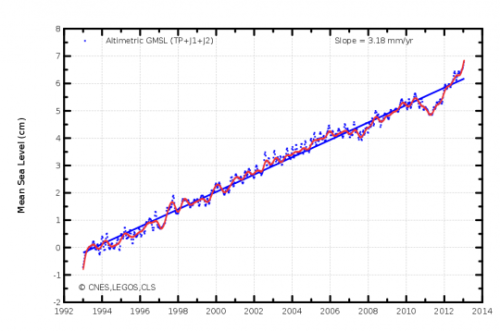
Hundred-Millimetre-per-Decade Uptick: In two years sea-level rise has jumped 20 millimetres, on the back of a downtick—climate quacks were quick to trumpet the downtick… The paleoclimate record indicates that if atmospheric carbon dioxide could be ‘contained’ at today’s all-but 400 parts per million, sea level would rest, in time, about 24 metres higher. chart CLS/Cnes/Legos
The CIA World Factbook ranks China’s 2012 population growth rate 152nd, the United States is ranked 28 positions higher at 124th. While the United States is adding only a third as many souls per year as China, a more than four times greater per capita greenhouse gas emission profile means that the United States’ extra two millions per year are probably contributing more emissions than China’s extra seven. Bizarrely, emissions created producing goods in China for consumption in the United States are counted solely as Chinese emissions, so Americans are still the greater polluters, despite claiming recent reductions down to 1992 levels.
Most population growth discussion in the United States appears to focus on the country’s more than one million immigrants per year, and the higher birth rate among new immigrants. So when moratorium is mentioned, particularly post the Boston bombings, it invariably refers to immigration, rather than the near global moratorium on births that is needed to avert widespread famine that is otherwise unavoidable, as warming impacts a population already many times that which is sustainable.
China and the United States have pledged to ‘contain climate change’. Limit would be a more accurate verb to describe what is possible even with a massive mobilisation, in the face of what veteran war correspondent Gwynne Dyer describes as lethal consequences for a large part of the human race:
First we go on growing our emissions at the current rate (3 per cent per year) for the next couple of decades, and the fossil fuel industry thrives. Then, when it’s already too late and we have crossed the +2 degree limit, the actual warming (which always lags the growth in emissions by a decade or more) frightens us into taking action at last.
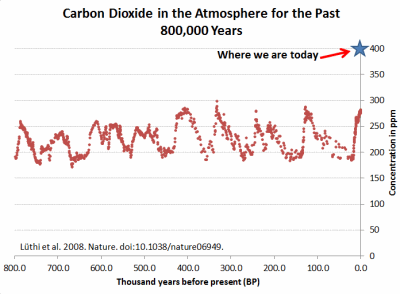
Grand Uptick: Although the ice core record only extends 800 000 years before the present, there is some evidence that the last time carbon dioxide levels were this high was during the Pliocene, between five and three million years ago. But, under business as usual, carbon dioxide is on its way 1000 parts per million above the already unprecedented uptick. chart Climate Progress
So we lurch into a crash programme to cut fossil fuel use—and suddenly the market wakes up to the fact that a lot of those reserves will have to stay in the ground forever. If you liked the sub-prime mortgage fiasco in 2008, you’ll positively love this one.
It’s not either Disaster A or Disaster B. It’s first one then the other, interlocking and mutually reinforcing. And Disaster B will mean there’s no money left to do anything about Disaster A.
Although many will struggle to believe that the United States is capable of ‘large-scale cooperative action’, those who care about the ‘consequences for a large part of the human race’, and a large proportion of its fellow species great and small, must find the audacity to hope. And Aotearoa and Australia must swiftly become allied in this ultimate sacrifice, and honour all the brave soldiers who cannot get older by fighting tooth and nail for a survivable population and climate.
Dawn of an Anzac struggle more desperate than Gallipoli.

I dropped the USA off my Christmas card list when their president lied about weapons of mass destruction in Iraq.